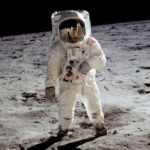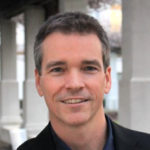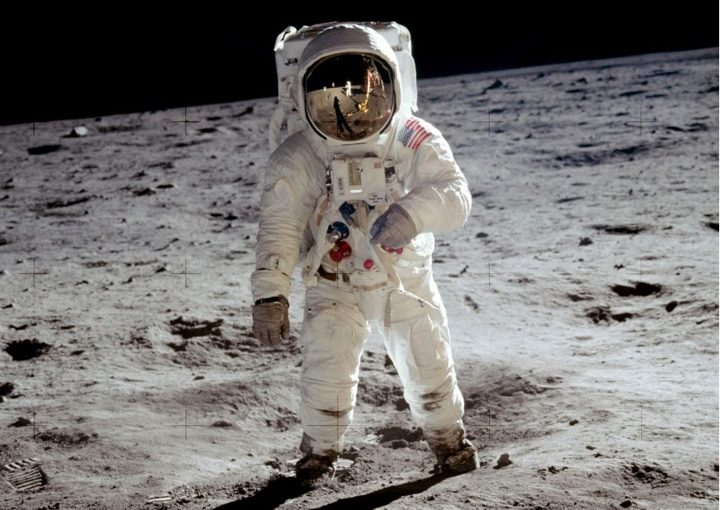Podcast: Play in new window | Download | Embed
Subscribe: RSS
Podcast (parenting-with-a-story-podcast-series): Play in new window | Download | Embed
Subscribe: RSS
 Renaissance artist Michelangelo once observed, “The greater danger for most of us is not that our aim is too high and we miss it, but that it is too low and we reach it.” I’m convinced that’s true, and perhaps best example of what happens to someone when they set high goals, even if they don’t reach them, is Bob Woolley.
Renaissance artist Michelangelo once observed, “The greater danger for most of us is not that our aim is too high and we miss it, but that it is too low and we reach it.” I’m convinced that’s true, and perhaps best example of what happens to someone when they set high goals, even if they don’t reach them, is Bob Woolley.
The Ambition
Ever since the 1960s, countless young boys and girls have spent their days dreaming of becoming an astronaut, orbiting Earth in the apparent weightlessness of space, or exploring strange new worlds as they saw their heroes do in episodes of Star Trek or movies like Star Wars.
Bob Woolley was one of them.
Bob describes himself as a child of the space age. He was born in 1953 in Little Falls, New York. One of his earliest memories, at the age of four, was learning about the first man-made satellite, Russia’s Sputnik, as it orbited Earth. He was fascinated at the very idea that human beings could make something that could circle the entire planet in just ninety minutes.
He recalls watching on February 20, 1962 (his ninth birthday), the television coverage of John Glenn orbiting Earth in the Mercury-Atlas 6, the first American to do so. An autographed picture he received from Mr. Glenn on the thirtieth anniversary of that orbit is one of Bob’s most treasured belongings to this day.
So the seeds of desire to become an astronaut were sown early. Most children’s dreams of becoming an astronaut are long abandoned by the time they’re in high school or college, but not Bob’s. When it was time to make his first career decisions, he studied what career paths those early astronauts, like John Glenn, had followed. And there was a clear pattern. Almost all of them had been military pilots of high-performance fighter jets. So that’s what he set out to do.
The Pursuit
He studied astronomy, physics, and geology at the University of Maryland. And in 1981 he joined the U.S. Navy and was assigned as a naval aviator to fly the supersonic F-14 Tomcat popularized in the movie Top Gun. To listen to Bob describe the thrill of flying such a powerful machine is an adventure in itself: going from zero to 150 mph in 2.5 seconds as you’re slingshot off the deck of an aircraft carrier; flying at top speeds around Mach 2 (over 1,500 mph); breaking the sound barrier the first time; doing 360-degree aileron rolls while flying straight up 25,000 feet off the ground; landing on a carrier deck that’s only a thousand feet long and looked the size of a postage stamp only a few seconds earlier; then dropping the landing hook and coming to a dead stop two seconds after touchdown.
Bob’s plan was definitely off to a great start. But as you can imagine, the competition to become an astronaut is intense. There have been fewer than 350 Americans admitted to NASA’s astronaut program in the fifty years of manned space flight. One of NASA’s many selection criteria for astronauts was flight time as a military or commercial pilot. At the time, to be eligible for the program candidates needed to have a minimum of 1,500 flight hours. Even though Bob spent eleven years in the navy, assignment changes and medical issues kept him grounded for much of that time. As a result, by the time he left, he was still short of that number. Bob left the navy knowing he would never be an astronaut.
But his love of space remained, and it took him on two more life adventures he never imagined when he was nine years old. First, with his astronomy training and navy experience, Bob had the perfect background to work at Space Camp at the U.S. Space and Rocket Center in Huntsville, Alabama. There, he managed the Aviation Challenge Program, where young people got to experience navy pilot training: flight simulation, land and water survival training, and ground school academics. He was inspiring future astronauts and loving it.
Next, he started his own tour company called Astronomical Adventures. He created one- to seven-day vacation programs under the beautifully dark skies thirty-five miles southeast of Flagstaff, Arizona. Picture yourself in the middle of a ninety-thousand– acre cattle ranch, miles from the nearest streetlight. By day, he took his guests on tours of the Grand Canyon, Meteor Crater, and the red rock formations in Sedona. Along the tour he explained the scientific and geological formation of each amazing structure. And at night he captivated and educated his guests with a personal tour of the night sky through enormous telescopes Bob built just for this purpose. Imagine a telescope three feet wide and eighteen feet long with a ladder alongside so you can reach the eyepiece. Again each awe-inspiring view came with a full scientific explanation.
Today, entering what most of us would describe as our retirement years, Bob is a high school teacher in math and science in Phoenix, where he lives. There, he shares his knowledge and passions with students, inspiring a whole new generation.
The Result
Now, if you’re waiting for a nice Hollywood ending where decades later Bob finally gets to become an astronaut, stop waiting. There isn’t one. Life’s rarely like that. No, Bob never did get to become an astronaut. But the point is, look at the amazing life he’s been living largely in pursuit of that dream. He flew supersonic jets in the navy, taught aviation at U.S. Space Camp, led his own personal exploration of the stars through Astronomical Adventures, and inspired hundreds of students with his passion and knowledge of astronomy, math, and science. And he’s loved every minute of it. When asked to reflect on what he started out to do and who he’s become, Bob smiles and observes, “What’s not to love? I’m an adult who was raised on my childhood dreams.”
The Lesson
Imagine instead if Bob had set his sights on less lofty goals. He may never have gotten to do the amazing things he’s done. Life has a way of getting in the way of whatever goals you set for yourself. Set them high enough, and you’ll not be disappointed wherever you land.
As with all my stories, I encourage you to share this with your kids, and then have a discussion about it. Here are some questions to get you started:
- Do you agree with the idea that it’s better to set high goals and fall short, than set low goals and achieve them? Why or why not?
- Would Bob have been better off trying to become a dentist or an engineer and being successful at it?
- What’s one dream or goal that you have for your life right now?
- What kind of things might you do on the road to achieving that goal?
- When would you consider not achieving one of your goals to be a failure so painful you would regret having ever tried?
[You can find this and over 100 other character-building stories in my book, Parenting with a Story.]
—
 Paul Smith is a one of the world’s leading experts on business storytelling. He’s a keynote speaker, storytelling coach, and bestselling author of the books Lead with a Story and Parenting with a Story.
Paul Smith is a one of the world’s leading experts on business storytelling. He’s a keynote speaker, storytelling coach, and bestselling author of the books Lead with a Story and Parenting with a Story.

 Connect with him via email here.
Connect with him via email here.
Follow him on Facebook, LinkedIn, Twitter.
Sign up for his newsletter here to get one new story a week delivered to your inbox.

